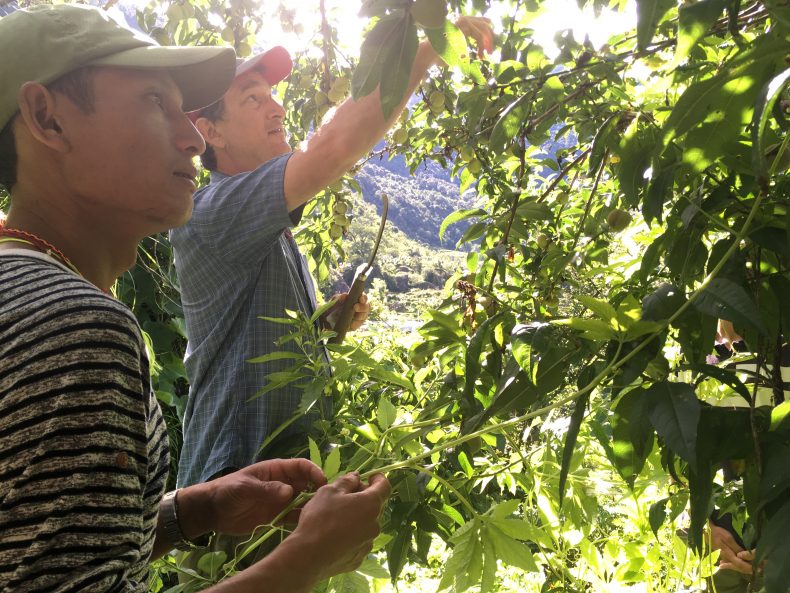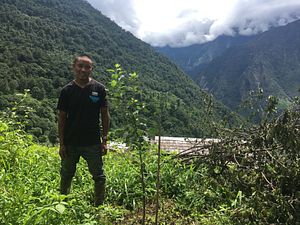SIMIGAUN, DOLAKHA, NEPAL — Standing on a narrow terraced field overlooking a deep Himalayan river valley, Pasang Undu Sherpa, 30, inspects an almond sapling, one of a couple dozen nut and fruit trees he planted earlier this year. Turning its boat-shaped leaves over in his calloused hands, he finds a small caterpillar, plucks it off, and throws it on the ground. He does not kill it; like most local Buddhists, Pasang Undu is reluctant to take animal life, although he does eat meat when killed by others.
The field is located on the outskirts of Simigaun, Pasang Undu’s village. Just 12 kilometers from the Chinese border, Simigaun rests at about 6,000 feet in altitude on a gentle slope above cliffs streaked with waterfalls that tumble into the Tamakoshi River, several thousand feet below. Tibetan mastiffs with thick coats saunter along village paths as smoke slowly rises from wood stoves inside temporary shelters, where most villagers have been living since the April and May 2015 earthquakes destroyed nearly every single home here.
Like millions of other Nepalis who cannot find jobs at home, Pasang Undu was abroad at the time of the earthquakes, working at a computer hard-drive factory in Malaysia. But when he heard his family’s home was destroyed, he decided to return to his village to help rebuild. Earlier this year, after receiving training from a local organization called Sparks, he joined several dozen other Simigaun residents in planting varieties of fruit and nut trees — including almonds, pecans, cherries, and apples. The trees are a new crop in Simigaun, where farmers traditionally grew millet, corn, and potatoes for subsistence. But Pasang Undu hopes that they will one day provide an income that will allow him to stay permanently in the village.
“My target is to be successful, and demonstrate to others,” he says. “Later, they can grow fruits as well, and I can collect them and sell them.”
A History of Migration
Although the Himalayas often feature in Western imaginations as a land beyond the reach of capitalism and the cash-economy, this is mostly a myth in Nepal today, and to some degree it has always been so. Remittances — money sent home from those working outside — have been important in mountain villages since at least the 19th century, when the British began to recruit Nepalis, especially from certain mountain ethnic groups, for the Indian Army. (According to the historian John Whelpton, around 100,000 so-called Gurkhas served in World War I and over 200,000 in World War II; more recently, British Gurkhas have served in Iraq and Afghanistan). Seasonal labor work in India, with which Nepal shares an open border, has long provided an important source of livelihood that supplements subsistence farming.
But migration has exploded over the past several decades, particularly after the government eased access to passports in 1991, and it has affected communities from Nepal’s lowland plains all the way up to its high mountains. Millions of Nepalis leave the country for jobs in factories, construction, and service in Malaysia, Saudi Arabia, Qatar, or the United Arab Emirates. Others migrate domestically for jobs in Kathmandu and regional cities, although these generally pay less. Men from ethnic Sherpa communities like Simigaun’s often go for seasonal work in the trekking and mountaineering industries centered on the famed Annapurna and Everest regions.
The increase in migration is driven in part by new needs for cash income.
For families in earthquake-affected areas like Simigaun, the foremost priority today is to rebuild homes. Although the government provides up to NRs. 300,000 (about $3,000) per household for reconstruction, grant disbursements have been slow and the sum is generally a fraction of the cost of replacing a house. Expenses are exacerbated by remoteness; according to a study by Amnesty International, the price of a brick produced in the capital, Kathmandu, can double by the time it reaches a village in Dolakha, the district where Simigaun is located.
Simigaun residents also spend significant sums on their children’s education. There is only one school in town, which only goes up to Class 5. Older children must study in boarding schools in lower-lying bazaars or in Kathmandu.
Healthcare is also expensive. There is one under-equipped government-health post in the village, but for any serious illnesses villagers must travel to the district hub, Charikot, or Kathmandu. Those who can afford it often opt for private hospitals, since the quality of care in government hospitals is seen as inferior.
While many migrants return to their villages after their time abroad, many others choose to settle in cities, where services like health and education are more readily accessible. Rural-to-urban migration became significant during the Maoist insurgency from 1996-2006, when people fled violence in villages, and it has continued as remittance income allows rural people to buy land in cities. Many Simigaun villagers have ended up in the Kapan neighborhood of Kathmandu, a chaotic jumble of new construction, near to the majestic Bouddhanath stupa that acts as a center of gravity for the city’s Buddhist communities.
Cash Crops: An Alternative to Migration
Although the benefits of migration are attractive, there are also significant costs. Migration can split up families, as spouses and parents spend years at a time away from loved ones. The work can be financially risky, since migrants must pay hefty sums to manpower agencies to secure jobs, and sometimes arrive abroad only to find that wages are less than originally promised. Working conditions can also be dangerous. Well over 5,000 Nepali workers have died in Qatar alone since 2008, many of them working on construction projects. Daily flights from the Middle East to Kathmandu carry returning migrants as well as the coffins of their fallen peers.
In response to the problems associated with migration, the Nepali government and NGOs alike have hailed the creation of local employment opportunities as an important alternative. Many development projects aim to introduce new crops to commercialize agriculture — on which 76 percent of households depend — so that young rural people do not need to migrate. In high mountain areas where large-scale farming and transportation are made difficult by the terrain, high-value crops that can be sold in small volumes are seen as particularly promising. These include fruit and nut trees, but also a variety of other crops like vegetables, mushrooms, and even medicinal plants.

Brent Willey of the Sparks Project and a local farmer inspect an older peach tree, planted before the project began. Image by Peter Gill.
But successfully introducing new cash crops is easier said than done.
“Oftentimes, there is a lot of excitement, but not enough due diligence before beginning a project,” says Brent Willey, a member of Sparks, the small organization that is helping Simigaun farmers plant the trees. Species must be selected carefully, since climatic conditions vary greatly across Nepal, due to differences in elevation, slope, and exposure. Mountains cast long shadows, so the amount of sun a location receives each day can vary greatly even in a small area.
Furthermore, farmers require long-term follow-up support to grow new crops.
“If you just drop the trees on people’s doorsteps and leave, or just give them one training and leave, then you don’t have much success,” says Willey. Compared to conventional crops that take three to six months from planting to harvest time, fruit and nut trees may take years to produce a crop. Previous government-sponsored projects in the area have distributed seedlings of avocado and the Nepali fruit lapsi, but they did little to teach farmers how to properly plant the trees or care for them in the years afterward.
The Sparks team say they take a different approach. So far, they are working in Simigaun and just a handful of other villages, where they provide tree saplings at subsidized rates — farmers must pay between 125 and 250 rupees ($1.20 to $2.40) per tree. The varieties used — including All in One and Shalimar almonds, Bing cherries, Fuji apples, and pecans — were carefully chosen because they are expected to thrive in Simigaun’s environment. Some of the foreign varieties were grafted onto rootstocks of local wild cherry trees, which are better adapted to the area’s soils. Sparks provided initial training and guidance for planting, and conducted several follow-up visits to monitor pests and any diseases, and then provided tailored solutions to the problems they found — including attacks by caterpillars, grubs, and even wild animals like porcupine. This winter, the group is providing another free-of-cost training for the farmers on tree care, including how to prune the branches properly to maximize fruit production.
Sparks also considered the potential marketability of the produce before promoting the trees in Simigaun.
“It’s pretty difficult to transport anything from the hills to Kathmandu, to a market,” says Judith Chase, the American founder of Sparks, who runs an organic farm and training center outside Kathmandu. “But you can store nuts for a long time, so the shipping is not a problem.”
In addition, expanding road networks near Simigaun, like elsewhere throughout Nepal, hold the potential to bring farmers closer to markets. Older community members remember a time when one had to walk for days just to buy rice in lower-altitude bazaars, or travel up to Tibet to buy salt. But four years ago, a dirt road was built to service a nearby hydropower project on the Tamakoshi river. Now, villagers must walk only one hour to reach the road, and in the coming years or decades, it is likely that a road will reach Simigaun itself.
A New Generation, a New Crop
In Simigaun, opinions about the new trees vary greatly depending on the age of the person you ask.
“I don’t know, it doesn’t seem great to me,” says Aiti Sherpa, 75, standing in a field where her son has planted almonds.
Over a cup of tea in his temporary shelter, Ang Lhakpa Sherpa, 60, explains that many older villagers prefer the traditional crops like millet, wheat, corn and potatoes. “We didn’t used to plant trees. The old people say, ‘We already have trees [in the forest], why should we plant new trees?’”
Indeed, nearly all of the tree-planters with whom Sparks works are under 40. Many are returned migrant workers who hope to stay in the village now that they have experienced life outside.
Tembi Sherpa, 30, who recently returned from Malaysia to marry his girlfriend, has planted apples and almonds. “The village is better than the city,” he says. “In the village, you can eat fresh vegetables, fresh food. The climate is better. If we have kids, we might have to plan for their education [outside the village] but for now this is good.”
Other tree-planters are still working outside the village, but have enlisted friends and relatives to look after their trees while they are away.
Ang Du Sherpa, 34, works for a mountaineering company based in Kathmandu and has summited Everest multiple times. He too has planted almond and cherry trees in Simigaun, which his parents now care for.
“I stay in the city because I have to,” he says. “I need to earn money while I’m still strong, and I need to educate my children.”
In the long-term, Ang Du hopes to leave the mountaineering business. He was on the mountain when major avalanches struck in 2014 and again in 2015, and lost friends in the tragedies. “It’s dangerous,” he says. “I do get scared. Nothing is certain.”
The trees, he hopes, will help him retire.
Peter Gill is an American freelance journalist based in Nepal.

































